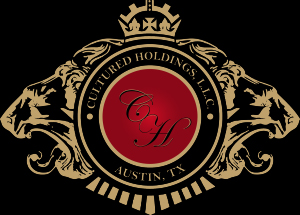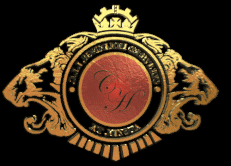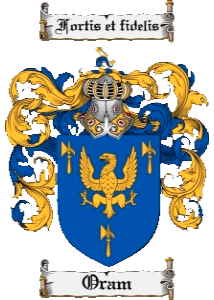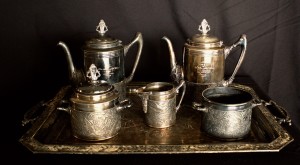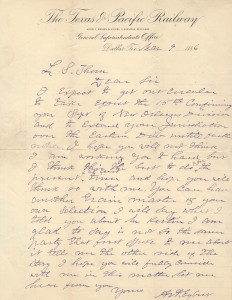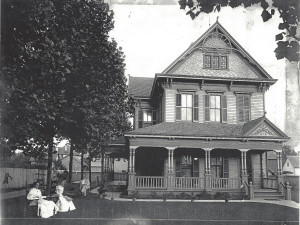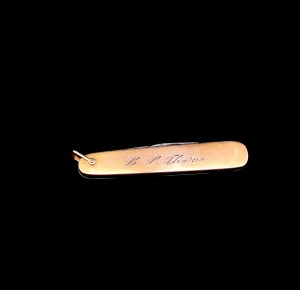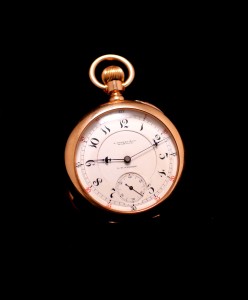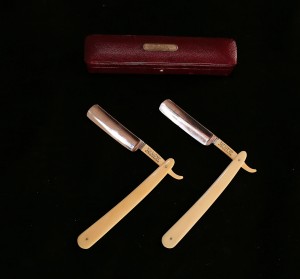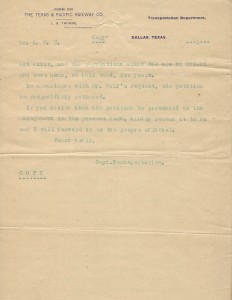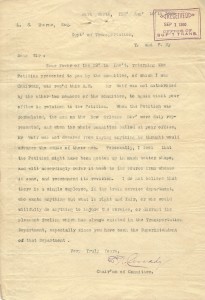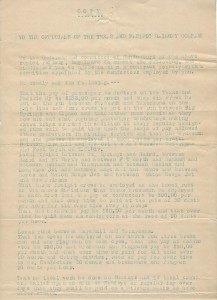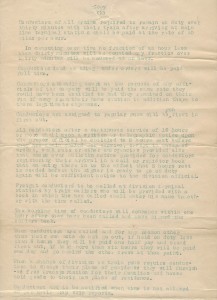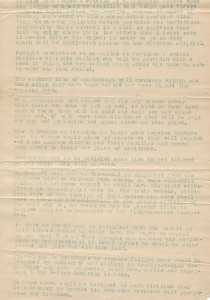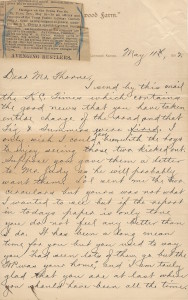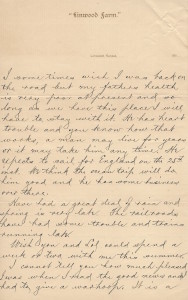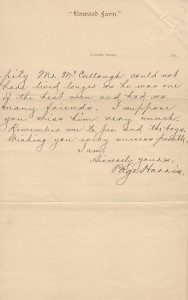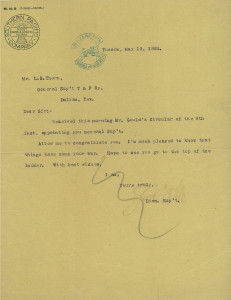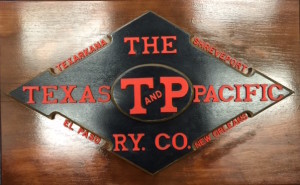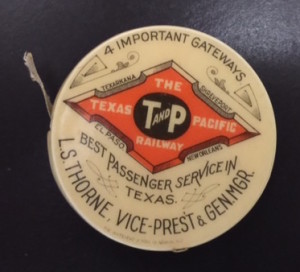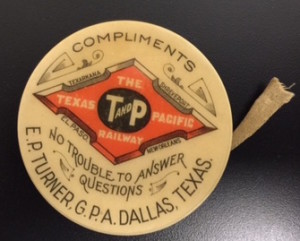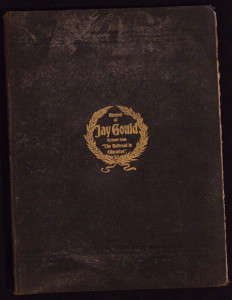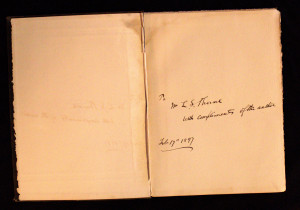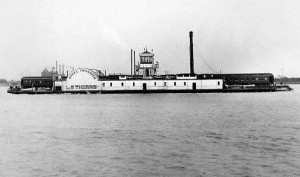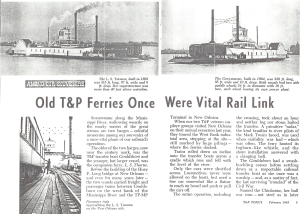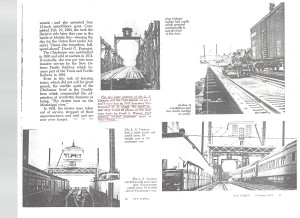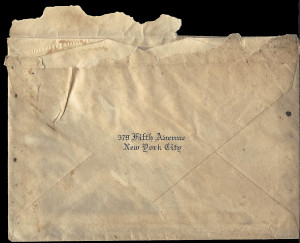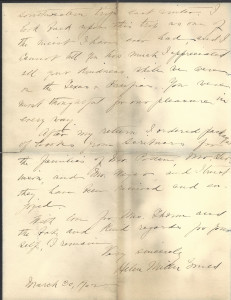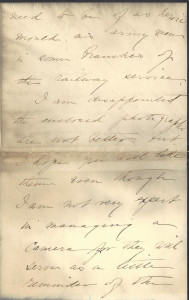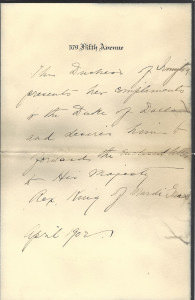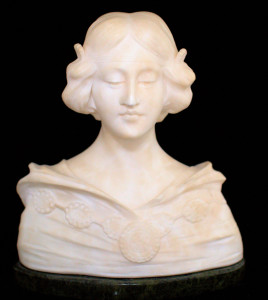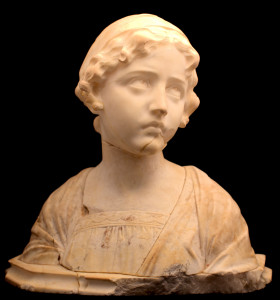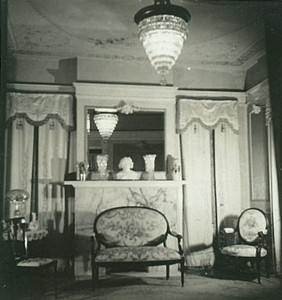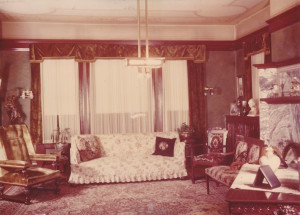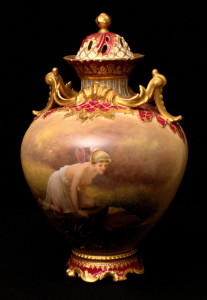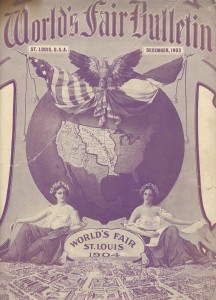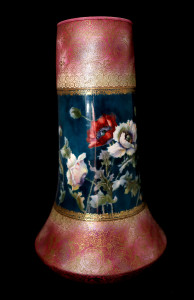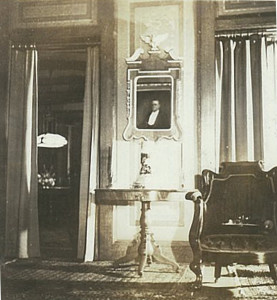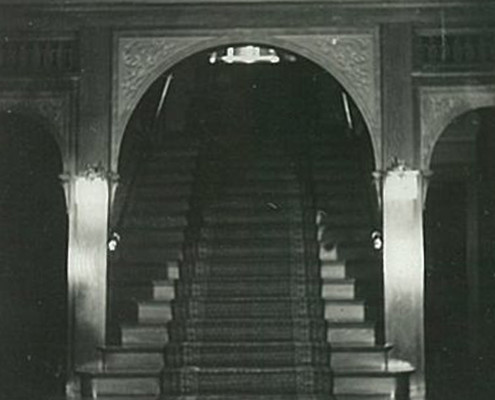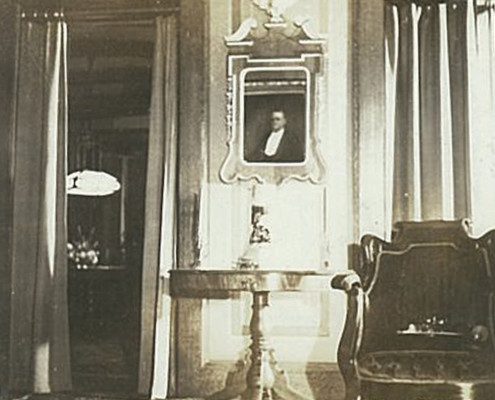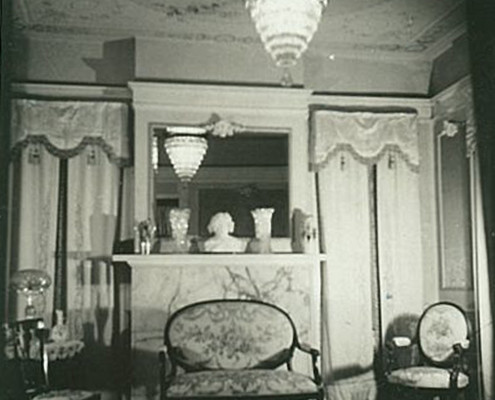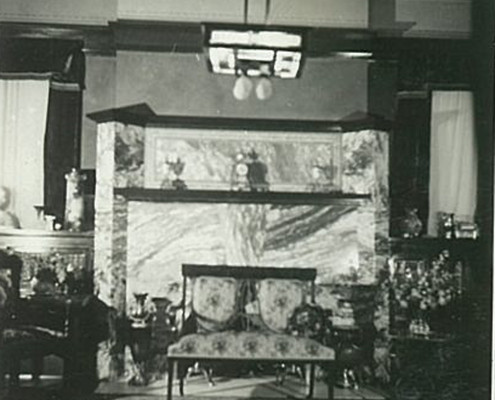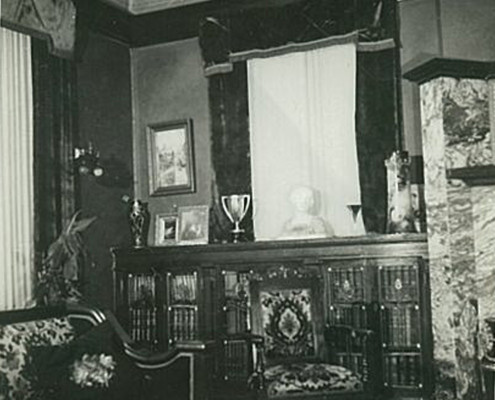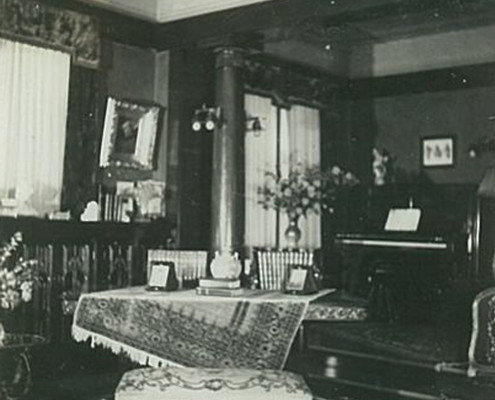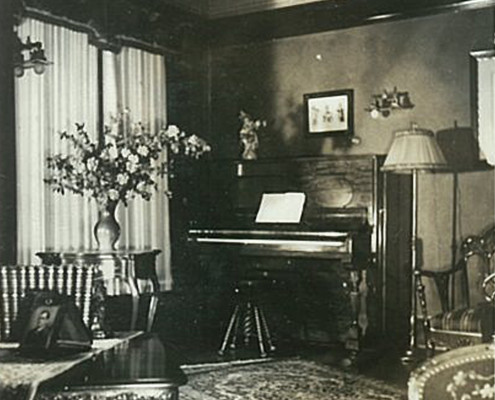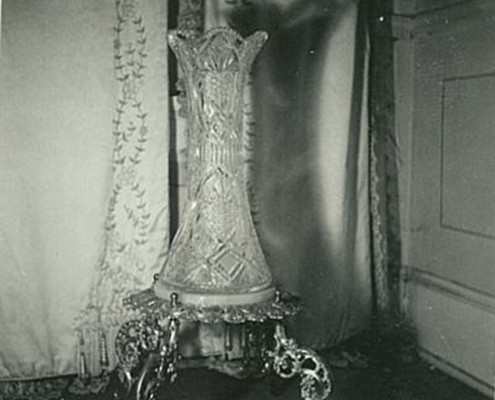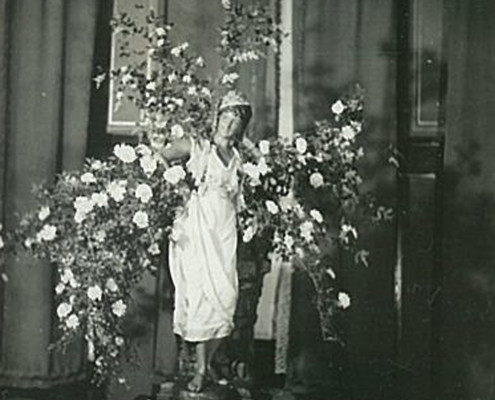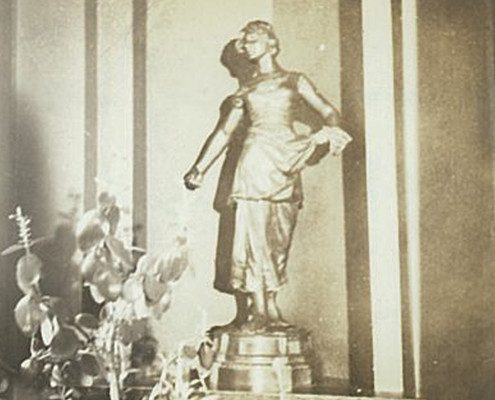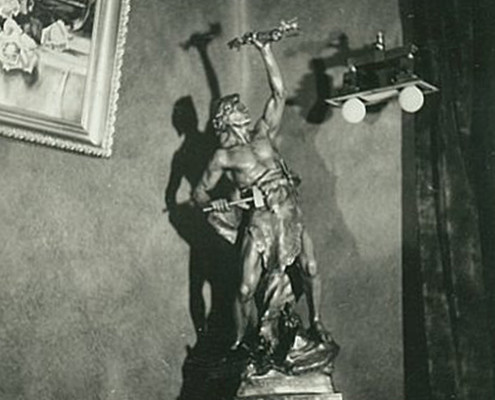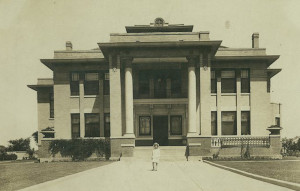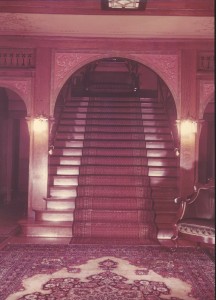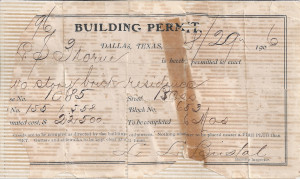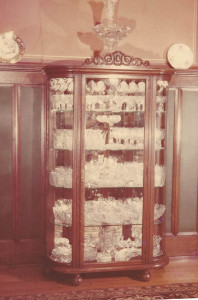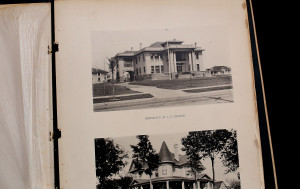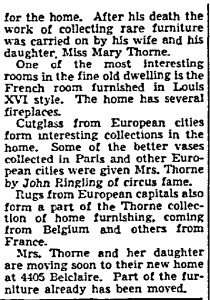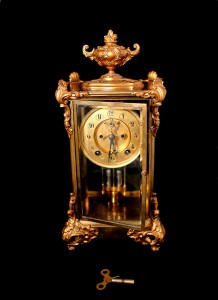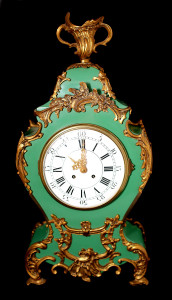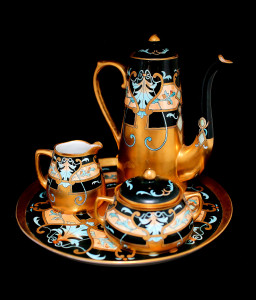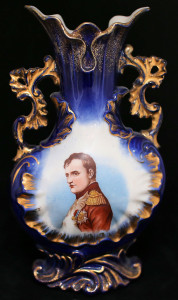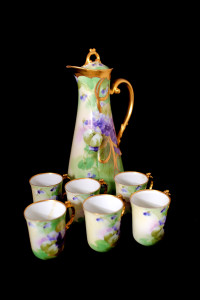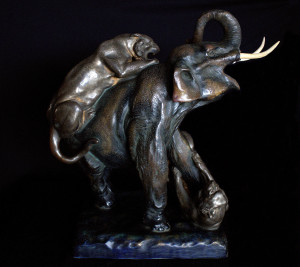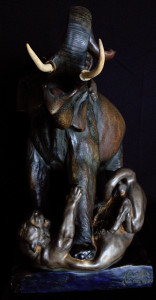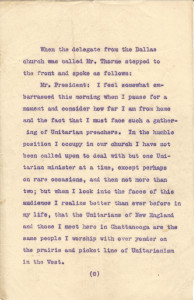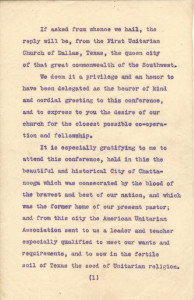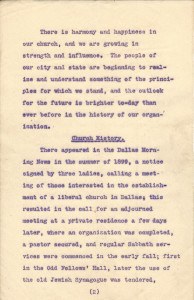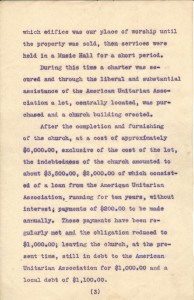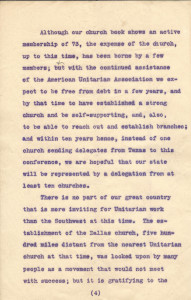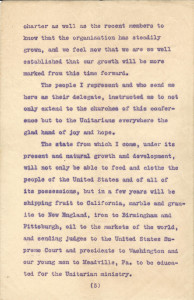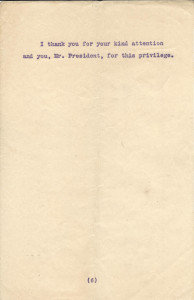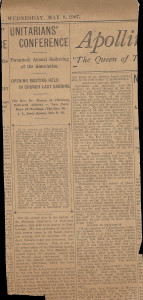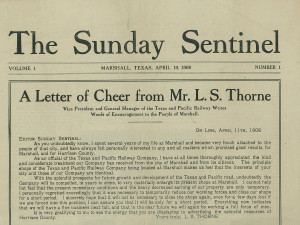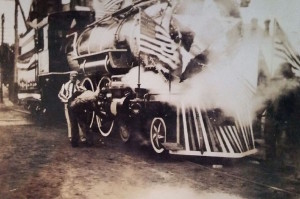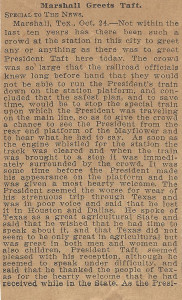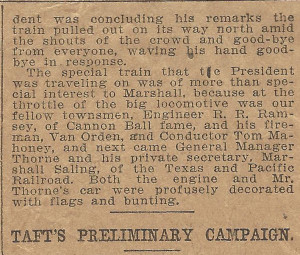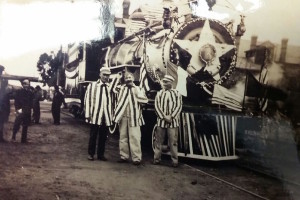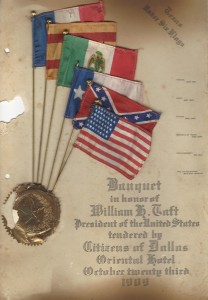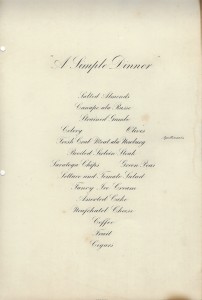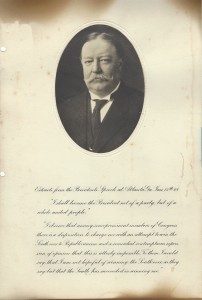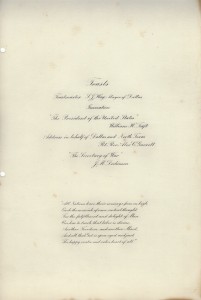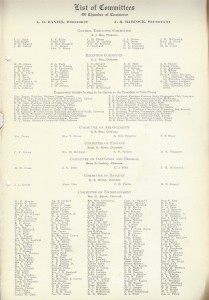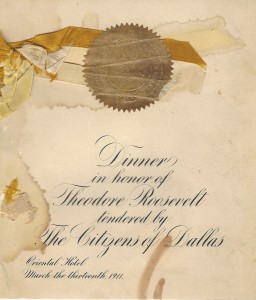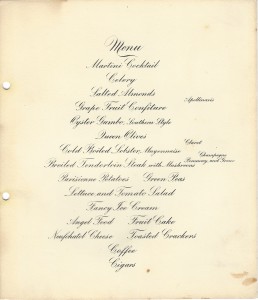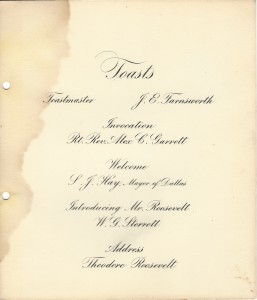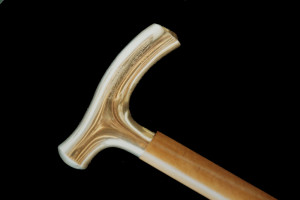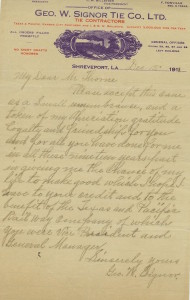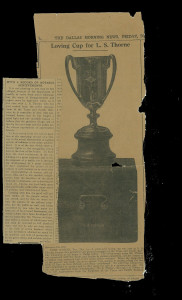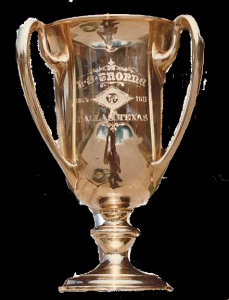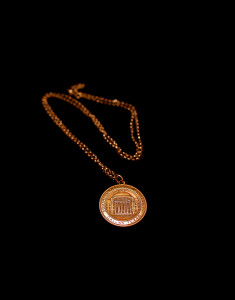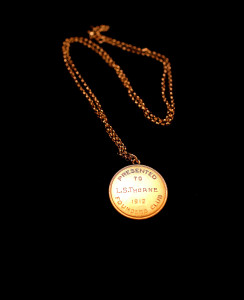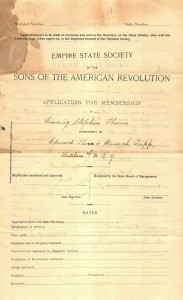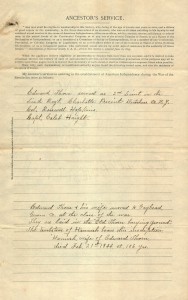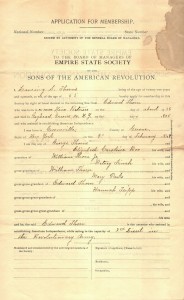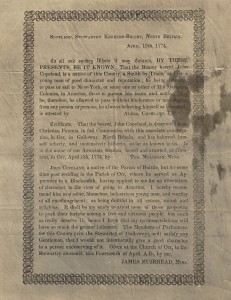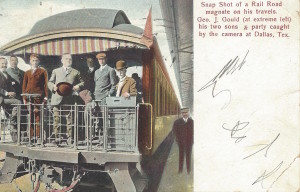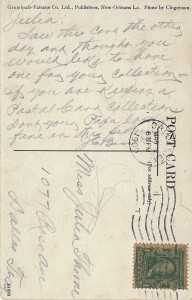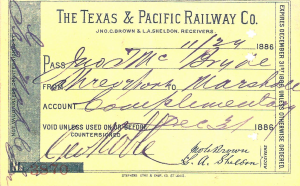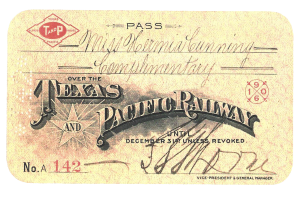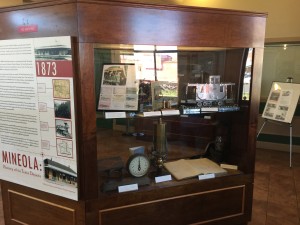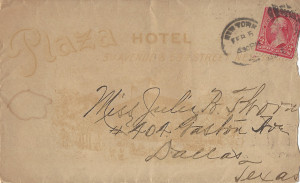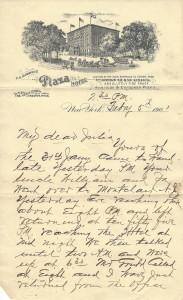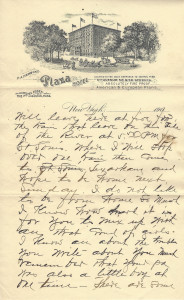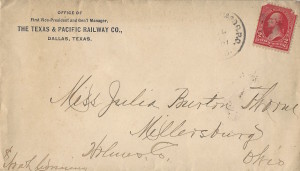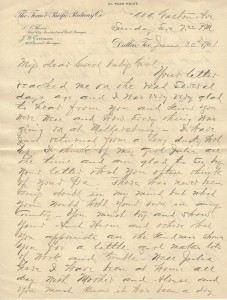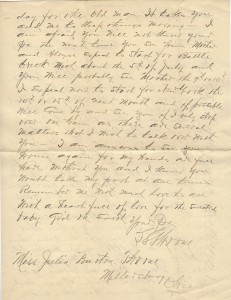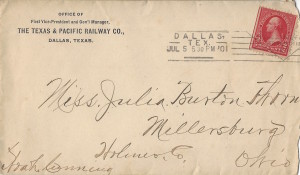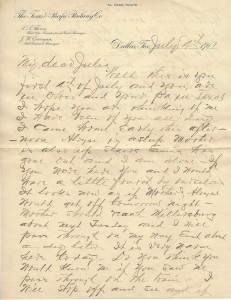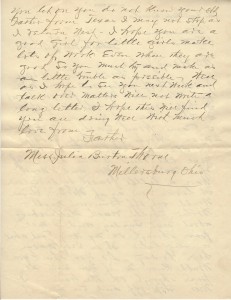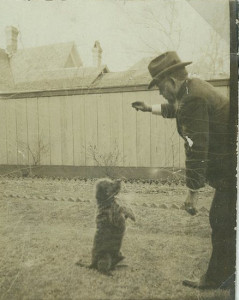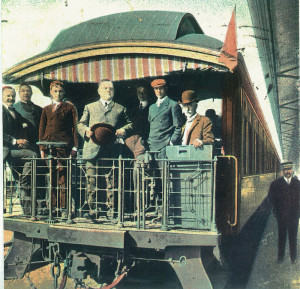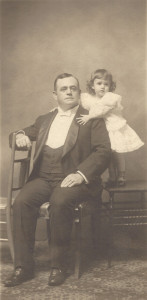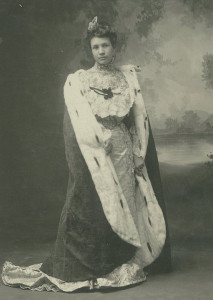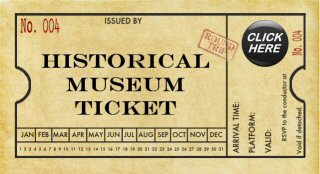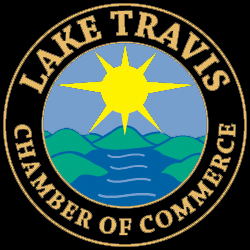L.S. “Charlie” Thorne
(1849 -1917)
L.S. Thorne was a railroad pioneer. Arriving in Texas in 1872, he spent most of his early life in Marshall, Texas and eventually moved his home and the headquarters of the Texas & Pacific railroad to Dallas TX, where he retired as the Third Vice President and General Manager of the company in 1911. As you browse this page you will have a chance to experience some of the instrumental artifacts that were connected to Mr. Thorne. Finishing with a brief read from the Encyclopedia of Texas., Vol III, you can enjoy a large collection of Mr. Thorne’s personal achievements and take a private look into the exciting life of a Railroad Magnate from the 1800’s.
Re-located T&P to Dallas TX 1886
(right) This local newspaper article details the promotion of LS Thorne to master of transportation for the Texas and Pacific Railroad and provides a look into the gift of the family heirloom tea set. As his co-workers knew their colleague felt all presents should be refused, they presented LS Thorne with an elegant solid silver tea set consisting of six pieces and a salver on which they had engraved: “To the mother of LS Thorne from his friends in Texas. As LS Thorne was leaving immediately for his new position, the tea set was purchased locally at Copeland Bros. and the engraving rushed to be finished in time for the 7pm presentation. LS Thorne upon receiving the set was greatly affected and graciously said he couldn’t receive it for simply doing his job, but as it was for his mother he valued it a thousand times more than anything that could have been done for him. Ms Caroline Turner, mother of LS Thorne, was living in Greenville, NY, at the time.
Tri-Weekly Herald, Marshall, TX. November 16, 1886
In this letter (right) to L.S. Thorne, it is confirmed that Thorne’s position of Supervisor of the New Orleans Division and, to an extent, his jurisdiction of the Eastern Division will be announced in the next circular distributed. From the Office of the T&P General Superintendent, Dallas, Texas March 9, 1886.
To the left you will see the first actual residence of LS Thorne that was located at 404 Gaston Ave, Dallas, Texas; between St Joseph Street and Washington Ave. 1895 – 1904
LS Thorne’s personal effects
When traveling across the country on a daily basis, it is imperative that you have all items engraved that could potentially be packed to travel. All of Mr. Thorne’s personal artifacts, silverware, and most jewelry was inscribed with either the Thorne name or the letter “T”.
Thorne’s 22k solid gold pocket knife. He kept this with him always.
Thorne’s solid gold watch was presented to him by Jay Gould.
Thorne’s razors and traveling kit. He took these with him on his long journeys across the country in his personal car.
US Railroad strike of 1890
In the following letter (right), Chairman of the Committee LW Canady is asking is LS Thorne, Superintendent of the Department if he will excuse the petition presented to him by Mr. Wolf as it was premature in its execution and not representing the full scope of men in the committee, only those in the New Orleans Division. Fort Worth, Texas. August 30, 1890.
(left) Chairman LW Canady is requesting a meeting with LS Thorne at his Dallas, Texas, office with Conductors JE Powell, George Tobin, or JC Hobart and himself to discuss a matter connected with the Transportation Department of the T&P Railroad. Ft. Worth, Texas. August 25, 1890.
(right) This letter is LS Thorne’s response to LW Canady’s letter regarding the petition from Mr. Wolf. LS Thorne denounced some of the unsatisfied feelings and grievances enumerated, reminded that the regulations called for are already in effect and asked that the petition be reviewed. He offered to send it to the proper management official if Canady wished to proceed as it was. Dallas, Texas. August 29, 1890.
1. (below) These three documents are the petition sent to LS Thorne, Superintendent of the T&P Railroad, from the Committee of Conductors of the railroad. They voiced their desire for financial compensation for their work in many situations on the job, as well as while their train is at the station and off the job, such as testifying in an official court situation.
2. (above) They asked for competitive wages, Sundays off, overtime pay for working on off days or Sundays, overtime pay for extra mileage, minimum set pay for a 100 miles or less in 24 hours, number of crewman necessary for brakes, flags and freight, and proper rest of more than 8 hours for conductors if they had been working more than 16 hours. The conductors asked that the company pay for relocation expenses if their station had been reassigned. Promotions were asked to be made on the grounds of seniority and ability.
3. (continued from last letter, below) The conductors pledged to avoid loss or breakage of the company’s property but not be fined if it did occur. Finally, they requested that they not be dismissed from their job without just cause, asked that they have 5 days after their dismissal in which to refer their case to the train master, and an appeal to the General Superintendent or General Manager be allowed. 1890.
General Superintendent of T&P 1892
This personal correspondence (right) from Page Harris to LS Thorne includes a small newspaper clipping from the Kansas City Times. The clipping echoes the timely news that Jay Gould’s T&P railroad had a new General Superintendent in LS Thorne and that John Grant had resigned as General Manager and LS Thorne let go WG Tignor, special agent of the road, and Mr. Summers, the roadmaster. Harris in his letter congratulated LS Thorne on his new position and voiced his support of him in his first acts in his newly acquired job. Several acquaintances are mentioned with the same sentiments of wishing LS Thorne the best on his latest endeavor on the railroad. Linwood, Kansas. May, 11, 1892.
The Division Superintendent of the South Pacific Company also wrote a letter (left) supporting and congratulating LS Thorne on his appointment by Jay Gould to General Superintendent of the Texas and Pacific Railroad. Tucson, Arizona. May 19, 1892.
The “old reliable” Texas and Pacific is perhaps in better condition, both physically and financially, than any other railroad west of the Mississippi river. It has never made any cut in salaries, and everybody is paid up promptly on the first of each month from one end of the road to the other, and this is something that can be said of very few roads in the country during these hard times. The Texas and Pacific goes even ahead improving and increasing its rolling stock, which keeps the shops running. It has three big new engines due to arrive in a few days. During the summer, a number of new bridges and depot buildings have been put up and the track placed in first class condition. The Texas and Pacific prepared for hard times in advance, and under the excellent management of General Superintendent, L. S. Thorne, it is pulling through in good shape, and will be in condition to enter upon an erea of genuine prosperity as soon as business eases up.
September 5, 1893, Dallas Daily Times Herald, p. 1, col. 4
These tape measures, which bear the saying “No problem to answer questions”, were given to customers as complimentary gifs to remind them of the friendly attitude and the unsurpassed service of the line. They bear the names LS Thorne and EP Turner.
~EP Turner (Close friend & associate of LS Thorne):
Among other brainy men whose talents it has abmrbed, may be mentioned the gentleman whose name heads this brief, friendly notice. E. P. Turner was born in Ottumwa, Iowa, in 1856, began railroading as a telegraph operator with the old Atlantic & Pacific Railway when 13 yeare of age; was ticket agent of the I. & G. N. Railroad at Houston in 1872, adopted the motto “No trouble to answer questions”, in 1876, and was ticket agent of the Texas & Pacific Railway Company for nearly twenty years prior to being appointed General Passenger and Ticket Agent of that line in 1897, which position he has since filled.
He is one of the most widely and favorably known railroad men in the country, has done an immense beneficial work not only for his line, but for Texas, and virtually, ae the pioneer in that direction, deserves great credit for introducing and applying in his dealings with the public those principles of kindness, courtesy, and accommodating helpfulness that lend a charm to private life — in a word, for demonstrating that it is possible to be a first class, dashing and capable business man and at the same time a polished and thorough gentleman. It is no trouble for him to answer questions, and, it may be said truly, there are none in his line that he can not answer. His home in Dallas is one of the most delightful and elegant in the State, for the reason that in early life, with his usual good sense, he placed “at the head of it”, as his wife, one of the fairest, best, and most accomplished daughters of the South.
~Source: Raines, Cadwell Walton. Year Book for Texas, p. 390. Austin, Tex: Gammel-Statesman Pub. Co, 1903.
~Thank you T&P Museum Marshall TX for the photos of this exhibit.
Passing of an old friend 1897
Memoire of Jay Gould
Extracts from “The Railroad in Education”
This book was a gift to L.S. Thorne from the author, Prof. Alex Hogg, MA:
In a show of affection, LS Thorne was presented with a copy of this book Memoir of Jay Gould- “The Railroad to Education” inscribed on the inside front cover with “To Mr. LS Thorne- with compliments of the author” February 17, 1897.
L.S. Thorne Ferry 1898 – 1941
L.S. Thorne
There have been at least seven railroad ferry operations in Louisiana, all involving the Mississippi River. Prior to the opening of the Vicksburg bridge in 1930 all rail traffic crossing the river used ferries. The Huey P. Long Bridge near New Orleans opened in 1935 so the Southern Pacific discontinued its ferry operations there. Nevertheless, the Texas Pacific – Missouri Pacific Terminal Railroad of New Orleans continued using its ferries until 1942. When the Baton Rouge bridge opened in 1940, the Louisiana & Arkansas abandoned its ferry but the Missouri Pacific continued its Baton Rouge – Anchorage ferry until 1947. The very last ferry operation along the Mississippi River was MP’s towboat and barge at Natchez-Vidalia, which made its last voyage in 1982. (Source: Railroad Ferries in Louisiana by Michael M. Palmieri)
For 60 years, from 1882 until 1942, the T&P relied on boats to carry freight and passengers between the west bank of the Mississippi and New Orleans. One of their vessels was the Gouldsboro, which was originally built in 1864 as an ironclad Union gunboat called the Chickasaw. It fought in the battle of Mobile Bay. After the war it was rebuilt as a car ferry and placed in service by the New Orleans Pacific (later Texas & Pacific) in February 1882. The other was the L.S. Thorne.
Gouldsboro
Photo and accompanying article of the “LS Thorne” steamferry based in New Orleans, Louisiana. It was one of 2 ferry boats, the other being the “Gouldsboro”, to shuttle passenger and freight trains to and from the ports of Gouldsboro on the west bank of the Mississippi and the TP-MP Terminal in New Orleans. Train cars, but not locomotives, would load on to the ferryboats in a process that would take nearly an hour, all weather permissible. The “LS Thorne”, the younger and larger of the 2 boats, could carry 19 freight cars or 10 passenger cars and the “Gouldsboro” could carry 10 freight cars or 6 passenger cars. The ferryboats were retired in 1941 and are now river barges. T&P Topics. February, 1955.
First Automobile Race in Texas 1901
This article (right) delve into the story behind the gold medal awarded to I.F. Johnson in the “1st auto race in America” on July 1, 1901. In an extremely convoluted history, the medal travelled from LS Thorne’s hands into IF Johnson’s before being rediscovered years later in Pasadena, California, held by an antiques collector. Magnanimously, LS Thorne gave his chauffeur, IF Johnson, the winning medal as Johnson had driven 3 of the 5 laps before falling behind and letting the car’s owner finish the race. Johnson cherished the medal, wearing it for years around his neck. The mystery remains how it got to California. Although Dallas enthusiastically described it as the “1st Auto Race in America”, in truth it was the “1st Auto Race in Texas”. The only 2 entrants in this race had the 1st car in Texas and Dallas, owned by Herbert Raff, and the 2nd car owned in Dallas, by LS Thorne. Thorne’s car had been purchased for him by the railroad magnate Jay Gould. In an interesting twist, despite these 2 cars being earlier, the 1st licensed car in Dallas was that owned by John Oram, whose granddaughter Elizabeth was married to LS Thorne, the grandson of the original LS Thorne who won the race. Throughout the years, The Thornes have retained a love of fine cars. July 1, 1901. Dallas Morning News, July 11, 1970. Dallas Morning News, November 3, 1996.
L.S. Thorne was given Car No.2 in Dallas, by his good friend and business partner Jay Gould, who owned the
Texas and Pacific and Missouri Pacific railroads.
The 1901 race was a 5-mile course with I. F. Johnson driving, but J.S. Thorne drove the last 2 miles, winning the race. Mr. Thorne had Mr. Johnson, his chauffeur’s name, inscribed on the gold medal and was awarded the prize.
The Linz Bros, Jewelers, was started in 1877. They made and still maintain the gold medal won by Isaac F. Johnson. In 1989, Zale’s Jewelry acquired the store but is still under the Linz logo.
Loss in the family 1902
This letter was written to LS Thorne after the passing of his brother. Helen Gould was a dear friend of the family.
Hymelia Crevasse 1903
The collection of articles displayed here depicted the dire situation at the Hymel Crevasse where a levee had broken in New Orleans, Louisiana. Recent floods, one of the worst ever seen at the time, had broken cribbing for the 3rd time but the railroad, planters, and workers were not willing to give up. LS Thorne, General Manager of the T&P Railroad, himself physically involved in this endeavor, pledged to be the last one to leave and committed his resources to assisting in the effort to help. The task included sacking, driving piling and the building of cribbing, batture, and flooring to withhold the high, flowing waters spanning 700 feet. Its durability was tested immediately as a barge struck the newly made cribbing. However, after 30 minutes all repairs were made, as the previous work had been well-constructed. LS Thorne acknowledged that accidents must happen and said that with each accident obstacles are overcome and work became stronger and more secure. The combined fight made by all men together over 10 days proved successful. Daily Picayune, New Orleans, Louisiana. March 31-April 7, 1903.
World’s Fair St. Louis 1904
All three of these alabaster busts were on permanent display throughout the Thorne Estate.
The gorgeous art pieces in this collection were all exhibited in the Texas building of the 1904 World’s Fair at St. Louis.
You will see the urn sitting on the table at the bottom right of this photo. It was displayed in the French Room of the Thorne Estate.
This floor vase (left) was prominently displayed in the hallway, across from LS Thorne’s self portrait hung. you can see the reflection in the eagle mirror. It was also on exhibit at the World’s Fair 1904.
Thorne Estate 1906
4703 Ross ave.
Photographs of the completed exterior (black and white), the grand staircase (sepia), formal living room (sepia and black and white), conservatory parlour (black and white), and statues and arrangements (black and white) gracing the interior.
The private home of LS Thorne was sold in 1945 to Frank Duff, a Dallas furniture man who said the residence would be used for a yet-named business purpose. The house was regarded as an aristocrat of Dallas homes. The 16 room, two story house was filled with rare and fine furnishings amassed during the Thorne’s residence there, collected by not only LS Thorne himself, but carried on by his wife and daughter after his death.
4703 Ross Ave. was the stately home of L.S. Thorne and his wife. Mrs. Thorne spent most of her time at this house in the company of her 2 daughters (Julia T. Marks and Mary L. Thorne), her 2 sisters (Hermia and Teeny), and her grandson (L.S. Thorne II) for whom she personally took a specific interest in his upbringing. Mrs. Thorne threw lavish parties and held extravagant events throughout her life in the estate.
Many of the ornate cut glass and crystal pieces (right) were gifts to the Thornes from the Ringling family of circus fame (article below).
(above) One of the most interesting rooms in the fine old dwelling was the French room furnished in Louis XVI style. The home had several fireplaces. Cutglass from European cities formed interesting collections in the home. Some of the better vases collected in Paris and other European cities were given to Mrs LS Thorne by John Ringling of the circus fame. Rugs from European capitals also formed part of the Thorne collection of home furnishings. Ms LS Thorne and her daughter, Mary, moved to their new home on 4405 Belclaire, also in Dallas. Dallas, Texas. 1945
The original building permit (above) for LS Thorne’s private two story residence on 1085 Ross Ave, Dallas, Texas. August 29, 1906.
Today, there is a plaque in the place of the original Thorne mansion. It reads: “Willis M. Bevers. Founder and Chairman of the Board. Merchant’s State Bank. On January 9, 1946, Willis M. Bevers opened Merchants State Bank in the old Thorne mansion on Ross Avenue. At the close of the day, deposits had exceeded 400,000 dollars each succeeding year, under his leadership. The bank realized steady growth, and is recognized as a sound and independent symbol in banking. On this day, January 16, 1972, Merchants Bank Building is dedicated by the Board of Directors in honor of Willis M. Bevers, whose perseverance, objectiveness, and loyalty to friends and customers have set the banking institution apart from all others.” Dallas, Texas. January 1972.
Pieces from the Thorne estate
John Ringing 1907
1. Arthur Strasser (1854-1927) was an Austrian sculptor and artist, world renowned for the Bronze sculpture of Mark Antony in his chariot being pulled by magnificent lions, which was exhibited at the Paris World Exhibition in 1900. He was also known for his naturalistic sculptures on a smaller scale, in both bronze and terra-cotta.
3. “The Invincible”, statue was a gift to LS Thorne by John Ringling of Ringling Brothers Circus fame. John Ringling gifted this magnificent Amphora piece, as a show of gratitude, to L.S. Thorne for the use of theT&P rails in Texas, enabling Mr. Ringling the ability to transport the Circus animals with greater ease, and across Texas.
Unitarian Conference 1907 – 1908
These are LS Thorne’s original notes for the address he gave before the Southern Conference of Unitarian churches in Atlanta entitled “The Unitarian Faith as a Working Force in Business”. LS Thorne preached that honesty, love, and kindness and acting as an example to others through life would set the Unitarian businessman apart from his peers. Atlanta, Georgia, May 1908.
In this open meeting, Thorne addressed the President of the US and fellow members at the Unitarian Conference in which he was a delegate (right). Succinctly, he acknowledged the privilege of his representation there and extolled the virtue of not only his denomination but of his own local church.
He gave a brief history of the Dallas church started in 1899 by three ladies wanting a liberal religion, their charter, and their newly constructed church building as well as their current number of active memberships and the finances of the church. Thorne told the conference that as Texas was growing in population and economy, so was the church and that is had become an established institution in its own right. Chattanooga, Tennessee. May 8, 1907.
A newspaper article (left) covering the 20th Annual Unitarians’ Conference in Chattanooga, Tennessee, in which LS Thorne was a delegate attending. The object of this conference was not to analyze the rise and progress of the church but to give the listeners an idea of the conditions that were when the religion’s founder established the church. The conference was to present an outlook for the future of the church based on the spirit and theology of which it was started- this is to say a philosophy of actions over words to benefit humanity and to ensure man believes in himself. A list of the conference’s events, speakers, and times are listed. Chattanooga, Tennessee. May 8, 1907.
LS Thorne attended the 20th Annual session of the Southern conference of Unitarian churches as a member of the Missionary council. A local newspaper article covered the closing day of this conference and declared it “A Feast of Reason and a Flow of Soul”. The three day conference was reported to have a tone of reverence and spirituality to a degree not usually associated with the denomination, culminating in the farewell address to the congregation by Rev. Dr. William Lawrence (Massachusetts). In addition to devotionals, members were taken on sight-seeing tours to local points of historical interest, including Lookout Mountain and Chickamauga Park. Atlanta, Georgia. 1908.
Following the Unitarian Conference in Atlanta, Georgia, LS Thorne wrote to fellow member Rev. Ulysses Pierce and received a reply which thanked him, assured him of the “royal” time he had, and mentioned how LS Thorne’s contributions in the Unitarian Conference were substantial in its success. Washington DC. May 12, 1908.
LS Thorne saved his copy of the 21st Annual Southern Conference of Unitarian Churches speaker program for the three day conference. Atlanta, Georgia. May 5-7, 1908
(right) Vice President and General Manager of the Texas and Pacific Railway LS Thorne wrote an open letter of encouragement to the people of Marshall, Texas, which was featured prominently in the city’s newspaper. During his tenure with the T&P, Thorne had spent several years there and felt a kinship with its residents and their well being. Because of monetary hardships and heavily decreased earnings of the company, local businesses had been shuttered and workforce laid off. Thorne promised that the shops would be closed only for a short time and only when forced into a position needing to do so. He forecasted that business was to improve in the fall and a full workforce of men then would be necessary. The Sunday Sentinel. Marshall, Texas. April 19, 1908.
President Taft visits Texas 1909
“Marshall Greets Taft” The excitement of the president’s trip through Marshall had been unprecedented. The crowds were so large that the Railroad had to anticipate the numbers and account for safety, traffic and viewing. He arrived on a special car throttled to a locomotive of local interest- it was carrying townsmen Engineer R Ramsey, Conductor T Mahoney, General Manager Thorne, and his secretary M Saling. Both cars were decorated for the occasion with flags and bunting. October 22, 1909.
photos courtesy of Marshall, Texas T&P Depot Museum
Mr.Thorne attended a Reception Committee to Presidents Taft’s inaugural visit to the State of Texas. Mr. Thorne’s Private guest car #400 was used as the exclusive vehicle for the length of the Presidents stay. The local papers (left) boasted of the ribbons and streamers attached to the T&P engines and caboose for this trip.
(below) Upon his election to President of the United States, WH Taft visited Dallas, Texas, with his Secretary of War and representatives of the principal newspaper and press associations from around the country. A banquet was given in his honor at the Oriental Hotel under the auspices of the Dallas Chamber of Commerce. The finest strip steak in Texas was suggested for the main course in which Taft declared it “somewhat of a pleasant surprise” and the best meal he had eaten in weeks. There were 6 plated tables for the president and guests. LS Thorne had the privilege to be seated across from President Taft at his table. At the conclusion of the meal, the president requested his menu card which was inside a calf leather portfolio lined with gray suede. The menu card was taken by all the guests and regarded as a highly valuable souvenir. Dallas, Texas. October 22, 1909.
President Taft Party Dinner Menu, October 23, 1909:
Taft welcomes a juicy steak; 3 page article
(left) Amongt the ten tables of reserved seats, L.S. Thorne was one of the prominent men that was personally invited to attend dinner at the Presidential Table with newly elected President, William H. Taft. Thorne was seated in Chair 25, directly across the Presidential table from Taft, in Chair 12.
Dinner with Colonel Roosevelt 1911
LS Thorne attended a dinner in honor of Theodore Roosevelt in Dallas and kept the dinner menu as a souvenir. Oriental Hotel. Dallas, Texas. March 13, 1911.
Retirement 1911
George Signor gifted LS Thorne with gold handled cane as a symbol of nearly two decades of his appreciation and gratitude of Thorne’s loyalty and friendship.
Signor promised to make the best of his association as a partner of the T&P Railroad. Shreveport, Louisiana. December 12, 1911.
Upon his retirement from 37 years working at the Texas and Pacific Railroad and an endeared man to many in the company, LS Thorne was presented with a solid gold loving cup.
The cup was engraved with: “ L.S. Thorne 1874-1911; A Token of Love and Appreciation from the Employees of the Texas and Pacific Railway”. Dallas Morning News. Dallas, Texas. December 14, 1911.
SMU 1912
1912 SMU Founders Club Gold Member
In 1912, L.S. Thorne and his wife Mary, contributed to the founding of the SMU University in Dallas. The Thorne family continues their philanthropic relationship with the school, even today.
The Founder’s Medals are gold lockets that Southern Methodist University gave people who made donations to the early establishment of the school. Everyone who received a Medal was a member of the Founder’s Club—or a Founder of the University. The initial contribution goal was $1 million, which was primarily collected from Texans. Designed by the Chas. M. Robbins Co. of Attleboro, MA, the lockets bear the image of Dallas Hall and the words “Veritas Liberabit Vos” (“The truth shall make you free”). The Robbins Co. produced the medals in five different grades, which were given to donors based on the size of the donation. SMU began awarding these medals in 1912 and continued for several years. Those receiving a medal had donated at least five dollars to SMU – a figure that, adjusted for inflation, now equals $104.75. Many donated much more than five dollars to support SMU at its founding, such as the members of the “One Thousand Hundred Dollar Club,” a group of 1000 people who each donated $100 to SMU. In celebration of the many people that made Southern Methodist University possible, a Founders’ Day was started; the first was held on March, 24, 1926. Regardless of the size of one’s donation, the Founders Medals represent an enduring sense of gratitude on behalf of SMU for those who generously supported the institution’s creation.
Thorne Ancestry
At the age of 55, LS Thorne strengthened his family name and pedigree with his application for membership to the New York Sons of the American Revolution. By tracing his lineage through five generations to Edward Thorne who assisted as a 2nd Lieutenant in gaining America’s Independence in the Revolutionary War, he was eligible and accepted.
The first generation Edward Thorne and his wife, Hannah, had moved to Gayhead Greene County, New York, at the close of the war. They are laid in the Old Thorne burying ground there. 1904.
John Copeland, a blacksmith, submitted his required mandatory recommendations in his application for his passage to America. Galloway, Stewartry Kerkend-Bright, Scotland, North Britain. April 15, 1774. (this letter was within Mr. throne’s heraldic collection)
Personal Correspondence
Early color photograph of the railroad magnate on his travels. George J. Gould (extreme left), his two sons, and party caught by the camera in Dallas, Texas
This personal family postcard depicts L.S. Thorne, several of the Gould’s, and several other party members in Dallas, at the rear of Mr. Thorne’s personal caboose #100 in 1909.
Below are examples of ticketed passes used on the Texas & Pacific system. 1886 – 1905
These tickets (and several other items) have been donated to the Mineola TX T&P Railway museum by the Thorne family and are currently on display at the Mineola TX Union Pacific train depot.
Encyclopedia of Texas Vol III
excerpt
Lansing Stephen Thorne, of Dallas was a pioneer in the railroad circles of the Lone Star State and had a career that perhaps has no equal in the annals of the railroad world. He came to Texas in 1874 and entered the employ of the of Texas & Pacific railroad in a minor position and became a dominant factor in the railroad circles of the Southwest, and his record and achievements will ever serve as an example to the struggling young men at the foot of the ladder throughout the country. A native of New York State, Mr. Thorne was born near Greenville, in Greenville County, February 8, 1849. His parents were George and Elizabeth (Roe) Thorne, his grandparents were: William and Betty (Finch) Thorne; his great-grandparents William and Mary (Parks) Thorne and his great-great-grandparents were Edward and Hanna (Tripp) Thorne. Edward Thorne was a second lieutenant in the Revolutionary War and is buried in the old Thorne family burying ground at Gayhead, New York.
L. S. Thorne received his early education in the schools of Greenville, N. Y., after which he was a student in Fort Edwards Academy, of New York. At the age of eighteen years young Thorne went west and joined a civil engineering corps engaged in surveying the route of the Central Pacific railroad. Later he became a clerk in the offices of the Kansas & Pacific railroad, then a conductor, soon being promoted to yard master in Lawrence, Kansas. In 1874, he entered the service of Texas & Pacific railroad as trainmaster becoming soon the first master of transportation. Later he was made district superintendent of transportation, and then general manager, and held these important positions up to the time of his retirement in 1911. In his early days he was with the Southern Pacific Railway for three years as superintendent of transportation and construction, laying the tracks for that railroad from Yuma, Arizona east to connections with the Galveston, Harrisburg, & San Antonio railroad at Houston.
Mr. Thorne was associated with the Texas & Pacific railroad for forty-seven years, during which time the trackage was increased from 1400 miles to twice that milage and had more than doubled its earning capacity.He was the chief instrument in the upbuilding of a great property, and in the development of a traffic for it, through the development of a great country, and conducted its affairs in such a manner as to meet with the commendation of owners and patrons alike, and to win marked compliment from the State Railroad Commission of Texas.
Mr. Thorne was married at Millersburg, Ohio, April 27, 1895, to Miss Mary Cumming, a member of a prominent family of that state. Her father, Noah Cumming, was a factor in the business life of his community, where he was held in the highest esteem by all who knew him, Her mother, Mrs. Julia (Burton) Cumming, was a member of a well-known family of Ohio. Mrs. Thorne’s grand-mother was a cousin of Daniel D. Thompkins, governor of New York State, and vice president of the United States. Two children were born to Mr. and Mrs. Thorne: Mrs. Julia Burton (Thorne) Laird and Miss. Mary Nancy Thorne. The Thorne home was located at 4703 Ross Avenue. Mr. Thorne died in Dallas, February 28, 1917. He was a member of the Dallas Country Club, the old Dallas club, the Unitarian Church and was a director of American Exchange National Bank. L. S. Thorne was modest, retiring, unpretentious, although there is no name that stands out with greater prominence than does his in the railroad and business circles of the Southwest. His career was a most remarkable one of few men have been so long in the railroad service of this country. To all who knew him his lovable traits of character impressed them, and the fine intelligence and sense of duty that he brought to the discharge of his official tasks, will remain forever in their memories. – The Encyclopedia of Texas
